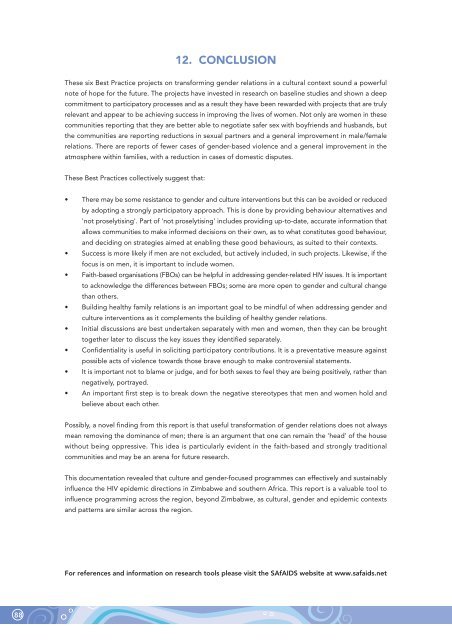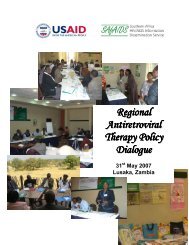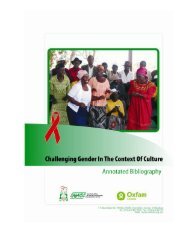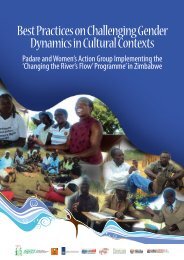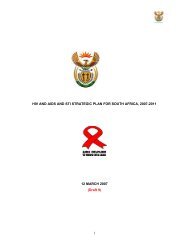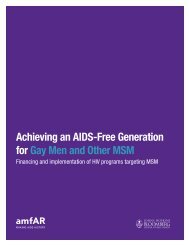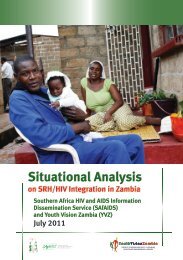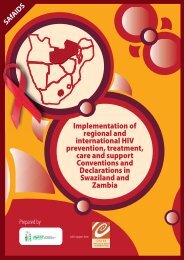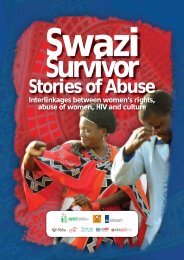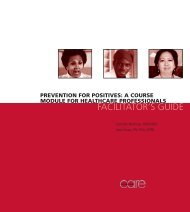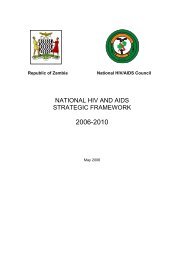Zimbabwean stories of "Best Practice" - SAfAIDS
Zimbabwean stories of "Best Practice" - SAfAIDS
Zimbabwean stories of "Best Practice" - SAfAIDS
Create successful ePaper yourself
Turn your PDF publications into a flip-book with our unique Google optimized e-Paper software.
12. CONCLUSIONThese six <strong>Best</strong> Practice projects on transforming gender relations in a cultural context sound a powerfulnote <strong>of</strong> hope for the future. The projects have invested in research on baseline studies and shown a deepcommitment to participatory processes and as a result they have been rewarded with projects that are trulyrelevant and appear to be achieving success in improving the lives <strong>of</strong> women. Not only are women in thesecommunities reporting that they are better able to negotiate safer sex with boyfriends and husbands, butthe communities are reporting reductions in sexual partners and a general improvement in male/femalerelations. There are reports <strong>of</strong> fewer cases <strong>of</strong> gender-based violence and a general improvement in theatmosphere within families, with a reduction in cases <strong>of</strong> domestic disputes.These <strong>Best</strong> Practices collectively suggest that:• There may be some resistance to gender and culture interventions but this can be avoided or reducedby adopting a strongly participatory approach. This is done by providing behaviour alternatives and'not proselytising'. Part <strong>of</strong> 'not proselytising' includes providing up-to-date, accurate information thatallows communities to make informed decisions on their own, as to what constitutes good behaviour,and deciding on strategies aimed at enabling these good behaviours, as suited to their contexts.• Success is more likely if men are not excluded, but actively included, in such projects. Likewise, if thefocus is on men, it is important to include women.• Faith-based organisations (FBOs) can be helpful in addressing gender-related HIV issues. It is importantto acknowledge the differences between FBOs; some are more open to gender and cultural changethan others.• Building healthy family relations is an important goal to be mindful <strong>of</strong> when addressing gender andculture interventions as it complements the building <strong>of</strong> healthy gender relations.• Initial discussions are best undertaken separately with men and women, then they can be broughttogether later to discuss the key issues they identified separately.• Confidentiality is useful in soliciting participatory contributions. It is a preventative measure againstpossible acts <strong>of</strong> violence towards those brave enough to make controversial statements.• It is important not to blame or judge, and for both sexes to feel they are being positively, rather thannegatively, portrayed.• An important first step is to break down the negative stereotypes that men and women hold andbelieve about each other.Possibly, a novel finding from this report is that useful transformation <strong>of</strong> gender relations does not alwaysmean removing the dominance <strong>of</strong> men; there is an argument that one can remain the 'head' <strong>of</strong> the housewithout being oppressive. This idea is particularly evident in the faith-based and strongly traditionalcommunities and may be an arena for future research.This documentation revealed that culture and gender-focused programmes can effectively and sustainablyinfluence the HIV epidemic directions in Zimbabwe and southern Africa. This report is a valuable tool toinfluence programming across the region, beyond Zimbabwe, as cultural, gender and epidemic contextsand patterns are similar across the region.For references and information on research tools please visit the <strong>SAfAIDS</strong> website at www.safaids.net88


